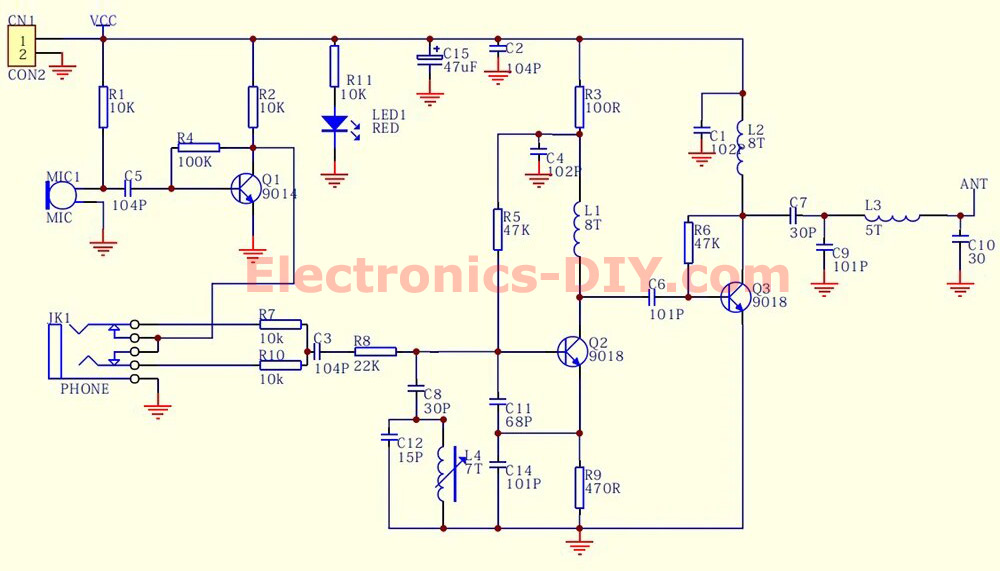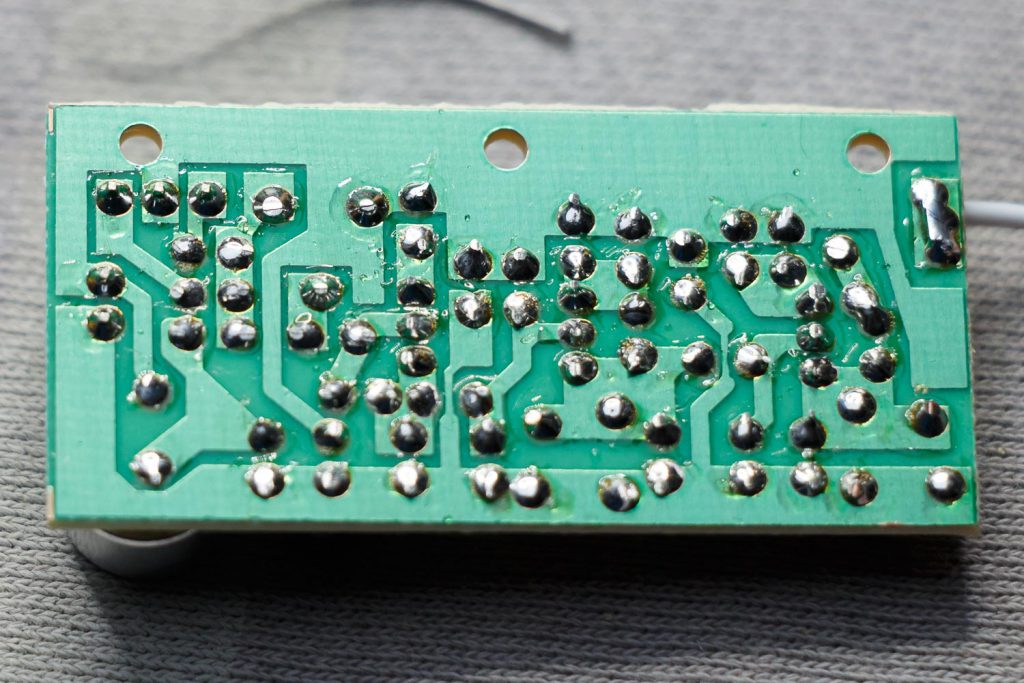| |
Broadcasting FM Transmitter |
|
With this three stage transistor transmitter we can create and broadcast our mini radio station. We using S9018 transistor because it can handle very high frequencies, up to and including the VHF band. The first transistor on the left is a microphone audio amplifier for modulation. The gain can be adjusted with the potentiometer. The second transistor is the oscillator with a range of 80 to 103 MHz. The frequency can be changed with the upper coil 4T5 by pulling it slightly apart. The signal from the oscillator is very small, so that still needs to be amplified. The right most transistor is therefore an RF amplifier. This amplifies the signal from the oscillator to feed to the antenna. This transistor also immediately provides more stability, because the oscillator is not directly connected to the antenna.

Function of the RF oscillator
A transistor is not an oscillator by itself. Only when you feed back its output to the entrance will you get it to strengthen itself. Compare that with a microphone that you hold in front of a speaker; the screaming sound is also oscillation. You can influence the tone of the screaming sound with your hands. And that's how it works with an RF oscillator. By placing a coil (the 4T5 mentioned here) and a capacitor in parallel with the input of the transistor, the transistor only becomes sensitive to a specific frequency. This frequency is called resonance frequency. You can therefore vary the frequency if you change the value of the coil and / or the capacitor. And that's exactly what you do when you pull 4T5 apart. There is a small paracitic capacitance in the transistor, which is voltage dependent. By offering music (with a varying voltage), the capacity therefore varies slightly at the base of T2. This influences the resonance circuit and the transmitter will vary slightly in frequency with the rhythm of the music. This is Frequency Modulation (FM). With 'real' FM stations this is done in a nicer way with for example varicaps.
RF Filter
Thus a coil and a capacitor in parallel form a frequency-specific whole. This is called a resonance circuit. But you can also use this principle as a filter by connecting them to something else. So that, for example, everything above 120 MHz is filtered out. The coils at the far right of the output have such a filter function. But also to let the amplifier work optimally at around 100 MHz.
Stability
Stability is always an issue with an FM bug, but due to the design with a buffer amplifier at the output and an audio amplifier at the input, the oscillator is somewhat isolated. But it is better not to sit at the antenna, because then the frequency will be strong.
Sound quality
I only tested it with the microphone. The sound quality was not disappointing at all, despite the method of modulation. There is, for example, no varicap in it or whatever. The audio is full, but could get a little more high. For speech it is sufficient. The amount of noise on the audio is not too bad, for an FM bug it is neat.
Power Supply
As a power supply it is best to use a 9V battery instead of an adapter or power supply. Due to the moderate disconnection you will otherwise have a very quick hum (even though the power supply is clean, something with a loop I think to the mains). The current consumption is approx. 34mA at 9V.

Related Links
Downloads
Broadcasting FM Transmitter - Link
|
|
|
| |
Accurate LC Meter
Build your own Accurate LC Meter (Capacitance Inductance Meter) and start making your own coils and inductors. This LC Meter allows to measure incredibly small inductances making it perfect tool for making all types of RF coils and inductors. LC Meter can measure inductances starting from 10nH - 1000nH, 1uH - 1000uH, 1mH - 100mH and capacitances from 0.1pF up to 900nF. The circuit includes an auto ranging as well as reset switch and produces very accurate and stable readings. |
|
PIC Volt Ampere Meter
Volt Ampere Meter measures voltage of 0-70V or 0-500V with 100mV resolution and current consumption 0-10A or more with 10mA resolution. The meter is a perfect addition to any power supply, battery chargers and other electronic projects where voltage and current must be monitored. The meter uses PIC16F876A microcontroller with 16x2 backlighted LCD. |
|
|
|
60MHz Frequency Meter / Counter
Frequency Meter / Counter measures frequency from 10Hz to 60MHz with 10Hz resolution. It is a very useful bench test equipment for testing and finding out the frequency of various devices with unknown frequency such as oscillators, radio receivers, transmitters, function generators, crystals, etc. |
|
1Hz - 2MHz XR2206 Function Generator
1Hz - 2MHz XR2206 Function Generator produces high quality sine, square and triangle waveforms of high-stability and accuracy. The output waveforms can be both amplitude and frequency modulated. Output of 1Hz - 2MHz XR2206 Function Generator can be connected directly to 60MHz Counter for setting precise frequency output. |
|
|
|
BA1404 HI-FI Stereo FM Transmitter
Be "On Air" with your own radio station! BA1404 HI-FI Stereo FM Transmitter broadcasts high quality stereo signal in 88MHz - 108MHz FM band. It can be connected to any type of stereo audio source such as iPod, Computer, Laptop, CD Player, Walkman, Television, Satellite Receiver, Tape Deck or other stereo system to transmit stereo sound with excellent clarity throughout your home, office, yard or camp ground. |
|
USB IO Board
USB IO Board is a tiny spectacular little development board / parallel port replacement featuring PIC18F2455/PIC18F2550 microcontroller. USB IO Board is compatible with Windows / Mac OSX / Linux computers. When attached to Windows IO board will show up as RS232 COM port. You can control 16 individual microcontroller I/O pins by sending simple serial commands. USB IO Board is self-powered by USB port and can provide up to 500mA for electronic projects. USB IO Board is breadboard compatible. |
|
|
|
|
ESR Meter / Capacitance / Inductance / Transistor Tester Kit
ESR Meter kit is an amazing multimeter that measures ESR values, capacitance (100pF - 20,000uF), inductance, resistance (0.1 Ohm - 20 MOhm), tests many different types of transistors such as NPN, PNP, FETs, MOSFETs, Thyristors, SCRs, Triacs and many types of diodes. It also analyzes transistor's characteristics such as voltage and gain. It is an irreplaceable tool for troubleshooting and repairing electronic equipment by determining performance and health of electrolytic capacitors. Unlike other ESR Meters that only measure ESR value this one measures capacitor's ESR value as well as its capacitance all at the same time. |
|
Audiophile Headphone Amplifier Kit
Audiophile headphone amplifier kit includes high quality audio grade components such as Burr Brown OPA2134 opamp, ALPS volume control potentiometer, Ti TLE2426 rail splitter, Ultra-Low ESR 220uF/25V Panasonic FM filtering capacitors, High quality WIMA input and decoupling capacitors and Vishay Dale resistors. 8-DIP machined IC socket allows to swap OPA2134 with many other dual opamp chips such as OPA2132, OPA2227, OPA2228, dual OPA132, OPA627, etc. Headphone amplifier is small enough to fit in Altoids tin box, and thanks to low power consumption may be supplied from a single 9V battery. |
|
|
|
|
|
Arduino Prototype Kit
Arduino Prototype is a spectacular development board fully compatible with Arduino Pro. It's breadboard compatible so it can be plugged into a breadboard for quick prototyping, and it has VCC & GND power pins available on both sides of PCB. It's small, power efficient, yet customizable through onboard 2 x 7 perfboard that can be used for connecting various sensors and connectors. Arduino Prototype uses all standard through-hole components for easy construction, two of which are hidden underneath IC socket. Board features 28-PIN DIP IC socket, user replaceable ATmega328 microcontroller flashed with Arduino bootloader, 16MHz crystal resonator and a reset switch. It has 14 digital input/output pins (0-13) of which 6 can be used as PWM outputs and 6 analog inputs (A0-A5). Arduino sketches are uploaded through any USB-Serial adapter connected to 6-PIN ICSP female header. Board is supplied by 2-5V voltage and may be powered by a battery such as Lithium Ion cell, two AA cells, external power supply or USB power adapter. |
|
200m 4-Channel 433MHz Wireless RF Remote Control
Having the ability to control various appliances inside or outside of your house wirelessly is a huge convenience, and can make your life much easier and fun. RF remote control provides long range of up to 200m / 650ft and can find many uses for controlling different devices, and it works even through the walls. You can control lights, fans, AC system, computer, printer, amplifier, robots, garage door, security systems, motor-driven curtains, motorized window blinds, door locks, sprinklers, motorized projection screens and anything else you can think of. |
|
|
|